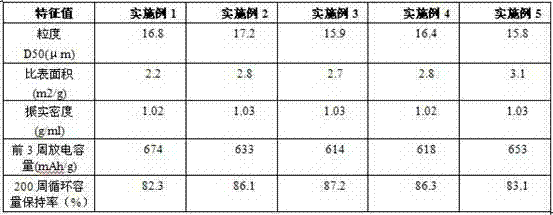Silicon-carbon composite material for lithium ion battery and preparation method thereof
A technology of silicon-carbon composite materials and lithium-ion batteries, which is applied in the direction of battery electrodes, circuits, electrical components, etc., can solve the problems of not fully reflecting the high capacity of silicon-based materials, achieve improved cycle performance, prevent pulverization, and improve cycle performance. performance effect
- Summary
- Abstract
- Description
- Claims
- Application Information
AI Technical Summary
Problems solved by technology
Method used
Image
Examples
Embodiment 1
[0013] 1. Pour 0.2kg sodium carboxymethyl cellulose and 20L water into a blender, and stir at high speed for 2 hours to obtain sodium carboxymethyl cellulose glue.
[0014] 2. Pour the glue solution into a mechanical high-energy ball mill, and at the same time put 8kg of spherical artificial graphite with a particle size of D50=11-13μm and a purity of 99.96%, and 2kg of silicon powder with a particle size of D50=4-5μm and a purity of 99.99%. The softening point of 0.1kg is The low-temperature asphalt at 80°C is poured into a mechanical high-energy ball mill, and ball milled for about 3 hours under the protection of an argon atmosphere, and the particle size of the material is detected to be below 100nm.
[0015] 3. Put the ball-milled slurry into a centrifugal spray dryer, spray dry and granulate by centrifugal spraying at 150°C, and test the particle size and specific surface area of the particles. The particle size is D50=15-19μm, and the specific surface area is below 4m2 / ...
Embodiment 2
[0037] 1. Pour 0.2kg sodium carboxymethyl cellulose and 20L water into a blender, and stir at high speed for 2 hours to obtain sodium carboxymethyl cellulose glue.
[0038] 2. Pour the glue into a mechanical high-energy ball mill, and at the same time put 6kg of spherical artificial graphite with a particle size of D50=11-13μm and a purity of 99.95%, and 4kg of silicon powder with a particle size of D50=4-5μm and a purity of 99.99%. The softening point of 0.1kg is The low-temperature asphalt at 80°C is poured into a mechanical high-energy ball mill, and ball milled for about 3 hours under the protection of an argon atmosphere, and the particle size of the material is detected to be below 100nm.
[0039] 3. Put the ball-milled slurry into a centrifugal spray dryer, spray dry and granulate by centrifugal spraying at 150°C, and test the particle size and specific surface area of the particles. The particle size is D50=15-19μm, and the specific surface area is below 4m2 / g That's...
Embodiment 3
[0053] 1. Pour 0.2kg sodium carboxymethyl cellulose and 20L water into a blender, and stir at high speed for 2 hours to obtain sodium carboxymethyl cellulose glue.
[0054] 2. Pour the glue solution into a mechanical high-energy ball mill, and at the same time, mix 8kg of microcrystalline graphite with a particle size of D50=11-13μm and a purity of 99.95%, and 2kg of silicon powder with a particle size of D50=4-5μm and a purity of 99.99%. The softening point of 0.1kg is The low-temperature asphalt at 80°C is poured into a mechanical high-energy ball mill, and ball milled for about 3 hours under the protection of an argon atmosphere, and the particle size of the material is detected to be below 100nm.
[0055] 3. Put the ball-milled slurry into a centrifugal spray dryer, spray dry and granulate by centrifugal spraying at 150°C, and test the particle size and specific surface area of the particles. The particle size is D50=15-19μm, and the specific surface area is below 4m2 / g ...
PUM
| Property | Measurement | Unit |
|---|---|---|
| particle size | aaaaa | aaaaa |
| softening point | aaaaa | aaaaa |
| particle size | aaaaa | aaaaa |
Abstract
Description
Claims
Application Information
 Login to View More
Login to View More - R&D
- Intellectual Property
- Life Sciences
- Materials
- Tech Scout
- Unparalleled Data Quality
- Higher Quality Content
- 60% Fewer Hallucinations
Browse by: Latest US Patents, China's latest patents, Technical Efficacy Thesaurus, Application Domain, Technology Topic, Popular Technical Reports.
© 2025 PatSnap. All rights reserved.Legal|Privacy policy|Modern Slavery Act Transparency Statement|Sitemap|About US| Contact US: help@patsnap.com

